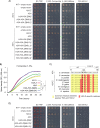What makes a histone variant a variant: Changing H2A to become H2A.Z
- PMID: 34871303
- PMCID: PMC8675926
- DOI: 10.1371/journal.pgen.1009950
What makes a histone variant a variant: Changing H2A to become H2A.Z
Abstract
Chromatin structure and underlying DNA accessibility is modulated by the incorporation of histone variants. H2A.Z, a variant of the H2A core histone family, plays a distinct and essential role in a diverse set of biological functions including gene regulation and maintenance of heterochromatin-euchromatin boundaries. Although it is currently unclear how the replacement of H2A with H2A.Z can regulate gene expression, the variance in their amino acid sequence likely contributes to their functional differences. To tease apart regions of H2A.Z that confer its unique identity, a set of plasmids expressing H2A-H2A.Z hybrids from the native H2A.Z promoter were examined for their ability to recapitulate H2A.Z function. First, we found that the H2A.Z M6 region was necessary and sufficient for interaction with the SWR1-C chromatin remodeler. Remarkably, the combination of only 9 amino acid changes, the H2A.Z M6 region, K79 and L81 (two amino acids in the α2-helix), were sufficient to fully rescue growth phenotypes of the htz1Δ mutant. Furthermore, combining three unique H2A.Z regions (K79 and L81, M6, C-terminal tail) was sufficient for expression of H2A.Z-dependent heterochromatin-proximal genes and GAL1 derepression. Surprisingly, hybrid constructs that restored the transcription of H2A.Z-dependent genes, did not fully recapitulate patterns of H2A.Z-specific enrichment at the tested loci. This suggested that H2A.Z function in transcription regulation may be at least partially independent of its specific localization in chromatin. Together, this work has identified three regions that can confer specific H2A.Z-identity to replicative H2A, furthering our understanding of what makes a histone variant a variant.
Conflict of interest statement
The authors have declared that no competing interests exist.
Figures








Similar articles
-
Key functional regions in the histone variant H2A.Z C-terminal docking domain.Mol Cell Biol. 2011 Sep;31(18):3871-84. doi: 10.1128/MCB.05182-11. Epub 2011 Jul 26. Mol Cell Biol. 2011. PMID: 21791612 Free PMC article.
-
NuA4-dependent acetylation of nucleosomal histones H4 and H2A directly stimulates incorporation of H2A.Z by the SWR1 complex.J Biol Chem. 2010 May 21;285(21):15966-77. doi: 10.1074/jbc.M110.117069. Epub 2010 Mar 23. J Biol Chem. 2010. PMID: 20332092 Free PMC article.
-
A protein complex containing the conserved Swi2/Snf2-related ATPase Swr1p deposits histone variant H2A.Z into euchromatin.PLoS Biol. 2004 May;2(5):E131. doi: 10.1371/journal.pbio.0020131. Epub 2004 Mar 23. PLoS Biol. 2004. PMID: 15045029 Free PMC article.
-
The specificity of H2A.Z occupancy in the yeast genome and its relationship to transcription.Curr Genet. 2020 Oct;66(5):939-944. doi: 10.1007/s00294-020-01087-7. Epub 2020 Jun 14. Curr Genet. 2020. PMID: 32537667 Review.
-
Reuniting the contrasting functions of H2A.Z.Biochem Cell Biol. 2006 Aug;84(4):528-35. doi: 10.1139/o06-077. Biochem Cell Biol. 2006. PMID: 16936825 Review.
Cited by
-
Characterizing the regulatory effects of H2A.Z and SWR1-C on gene expression during hydroxyurea exposure in Saccharomyces cerevisiae.PLoS Genet. 2025 Jan 21;21(1):e1011566. doi: 10.1371/journal.pgen.1011566. eCollection 2025 Jan. PLoS Genet. 2025. PMID: 39836664 Free PMC article.
-
Truncating the spliceosomal 'rope protein' Prp45 results in Htz1 dependent phenotypes.RNA Biol. 2024 Jan;21(1):1-17. doi: 10.1080/15476286.2024.2348896. Epub 2024 May 6. RNA Biol. 2024. PMID: 38711165 Free PMC article.
-
Replacement of Arabidopsis H2A.Z with human H2A.Z orthologs reveals extensive functional conservation and limited importance of the N-terminal tail sequence for Arabidopsis development.Genetics. 2025 Jun 4;230(2):iyaf065. doi: 10.1093/genetics/iyaf065. Genetics. 2025. PMID: 40179256
-
Epigenetic stress memory: A new approach to study cold and heat stress responses in plants.Front Plant Sci. 2022 Dec 8;13:1075279. doi: 10.3389/fpls.2022.1075279. eCollection 2022. Front Plant Sci. 2022. PMID: 36570899 Free PMC article. Review.
-
Histone variant H2A.Z modulates nucleosome dynamics to promote DNA accessibility.Nat Commun. 2023 Feb 11;14(1):769. doi: 10.1038/s41467-023-36465-5. Nat Commun. 2023. PMID: 36765119 Free PMC article.
References
Publication types
MeSH terms
Substances
Grants and funding
LinkOut - more resources
Full Text Sources
Molecular Biology Databases
Research Materials

